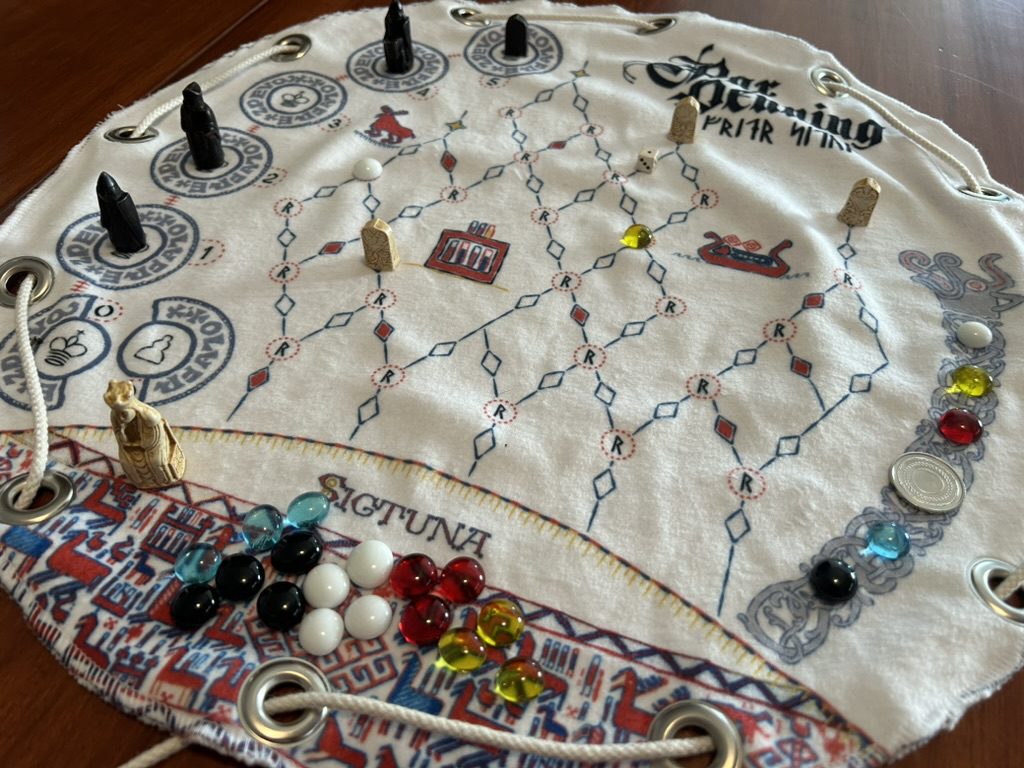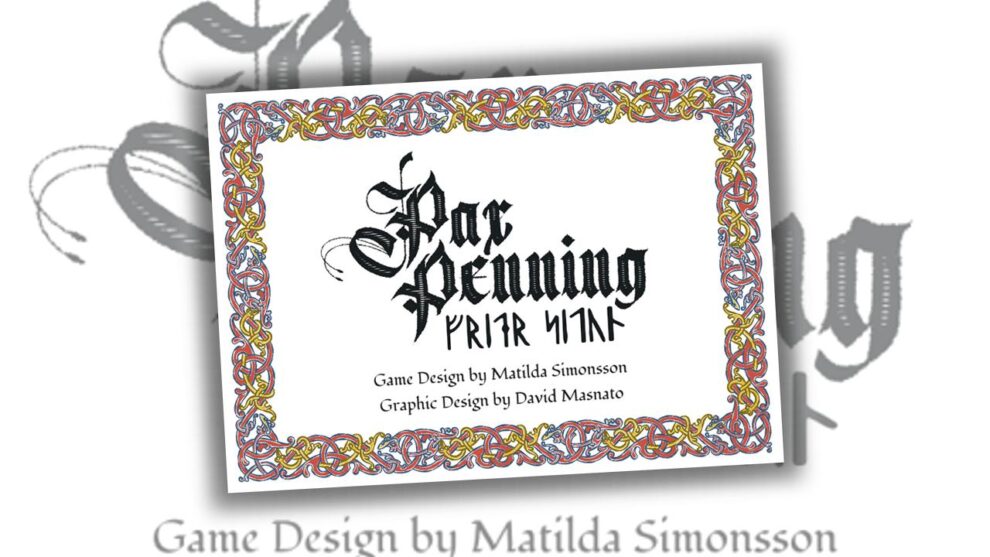Disclosure: Meeple Mountain received a free copy of this product in exchange for an honest, unbiased review. This review is not intended to be an endorsement.
Pax Penning, like all the Pax games, has Things on Its Mind. The entire Pax family is concerned with political turbulence and periods of significant change. Your job, from one design to the next, is to ride the waves as best you can. Unlike most games, the pieces on the board in Pax designs do not belong to any one player. You may control them temporarily, but nothing is yours, nothing is mine. It’s all a loose series of associations and temporary partnerships.
Pax Penning is not part of the formal Pax series, which primarily consists of games from designer Phil Eklund and publisher Ion Game Design, but it is clearly made in the same spirit. It earns the title. Players represent the various Houses in the town of Sigtuna, ca. 1000 CE, navigating the political ramifications of changes implemented by the first Christian King of Sweden, Olof Skötkonung. You have to decide whether or not you support him.

The ways in which you answer that question are abstracted enough that it’s easy to forget what you’re deciding, even if the production keeps you firmly grounded in the right time and place. That extends to the manual, which is full of interesting footnotes about the period depicted. Those footnotes have another aim: designer Matilda Simonsson is all too aware of the co-opting of Viking imagery by white nationalists around the world, and has no interest in allowing that audience to do the same to her game.
As an explanation of how the game works, the manual for Pax Penning is good, but only if you’ve played the game before. It isn’t the GMT problem, by which I mean this is not a reference document rather than a manual. It’s just that Pax Penning is a difficult game to describe. It is a collection of individually straightforward mechanisms that sum up to a murky total. Fundamentally, it is a game of influence, and, in its own way, a game of negotiation.
Each player has a screen, behind which sits a collection of stones. Stones represent influence, the shifting allegiances amongst different families. Over the course of the game, those stones get passed around, or even removed, with potential ramifications for who wins the game. In front of each screen are coins, which are not used as currency. They too represent allegiances of a sort. The blank side, Silver, lets you roll more dice at the beginning of your turn. Every time you roll a matching pair, you get to displace a stone from your house. It doesn’t have to be one of your own; you can displace another player’s too. The engraved side, the Penning, represents loyalty to the King, and the number of Pennings you have determines which actions are available to you on your turn.
Each action is connected to a beautiful resin chess piece. The King, the Rook, the Knight, the Bishop, and the Pawn all resemble period-appropriate chess pieces carved from stone. The cloth bag that holds Pax Penning and doubles as its board—a trick designer Matilda Simonsson borrows from her own Turncoats—is also striking. The design work that has gone into Pax Penning is careful, attentive, and as a result, it is evocative.

The actions are not complex. You can advance Pawns along paths on the board, which again facilitates the movement of stones. You can directly spread influence among the Houses, or place dice on the board that represent societal decay. You can shift the hierarchy of the Houses. This may all be an oversimplification, but that is the gist. The actions that comprise each turn are sort of beside the point with Pax Penning.
As the game goes on, the King travels about the region, moving in a circular path from coin to coin in front of the players. Hosting royalty is, of course, an honor for your House, but it also takes up resources. Whether Silver or Penning, the coin occupied by the royal party doesn’t count towards anything. It is in a player’s interest to move them on to other pastures, but that also accelerates the end of the game.
The end is perhaps the greatest source of Pax Penning’s impermeability. There are overlapping factors that determine how and when and in what way the end happens, to say nothing of determining who wins. Just know that, should you win, the plurality of the stones behind your screen better be yours. If any other player owns the lion’s share of stones in your House, that player is your heir, and takes your victory. Their victory itself can then be claimed by another Heir, whose victory could potentially be…you get the idea. This creates a fascinating dynamic at the table, one in which, during a good game, no player ever feels fully in control. Pax Penning is slippery. No one part of it is complicated, but staying on top of how it all interacts is difficult.

Despite the obfuscation I’ve described, and my continued inability to fully explain this game, you do learn to ride the worm, so to speak. You get comfortable, or at least comfortable enough. And then you realize that Pax Penning is, more than anything else, funny. At five players—far and away the best player count—it is deeply, deeply funny. You reach a point where every single decision has weight behind it. Because the ground beneath you is constantly shifting, you’re always losing your footing. Not so much that you feel yourself to be flailing, but just enough that nearly every move evokes a cuss from someone else.
Emphatically not a game for everyone, Pax Penning is an exquisite choice for those who are inclined towards it. As you go, it reveals itself to you. The knock-on effects of all your choices slowly take shape. You realize how it all works, and just in time for the game to get away from you. Pax Penning is a magnificent game.










